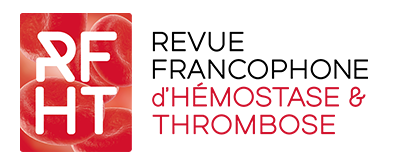RÉSUMÉ
L’embolie pulmonaire (EP) et la thrombose veineuse profonde (TVP) sont les deux principales présentations cliniques d’une même entité, la maladie veineuse thromboembolique (MVTE). La MVTE constitue un problème de santé publique majeur en raison de sa fréquence (incidence annuelle entre 1 et 2 cas pour 1 000 habitants par an) et est associée à des complications à long terme qui affectent la qualité de vie des patients. Les complications majeures sont la récidive de la MVTE et des séquelles résiduelles dues à la mauvaise résorption du thrombus (syndrome post-thrombotique ou hypertension pulmonaire thromboembolique chronique). Cette maladie est plurifactorielle, impliquant des facteurs de risque cliniques (chirurgie, cancer, exposition hormonale aux estrogènes, grossesse) et/ou biologiques, héréditaires (thrombophilies héréditaires), ou acquis (anticorps antiphospholipides). Cependant, dans 50 % des cas aucune cause n’est identifiée et on parle alors de MVTE idiopathique.
La triade de Virchow décrit traditionnellement les 3 facteurs majeurs impliqués dans les mécanismes physiopathologiques de la MVTE que sont l’hypercoagulabilité, la dysfonction endothéliale et les changements hémodynamiques (stase et sténose).
Cependant, la contribution des mécanismes inflammatoires dans la physiopathologie des thromboses est aujourd’hui bien décrite. Dans cet article, nous discuterons du rôle majeur de l’endothélium dans la thromboinflammation et comment il contribue à la formation et à la résolution de la MVTE.
MOTS CLÉS
cellule endothéliale, DAMPs, inflammation, thrombose veineuse
ABSTRACT
Venous thromboembolism (VTE), which encompasses deep venous thrombosis (DVT) and pulmonary embolism (PE), is the third leading cause of cardiovascular death after myocardial infarction and stroke. VTE is a frequent disease, 1 to 2 cases per 1,000 inhabitant per year, associated with long term complications affecting life expectancy and quality of life of patients. Major complications include recurrent VTE and conditions associated with incomplete thrombus resolution after DVT (post-thrombotic syndrome) or after PE (chronic thromboembolic disease and chronic thromboembolic pulmonary hypertension). VTE is a multifactorial and complex disease involving clinical (surgery, cancer, hormonal exposure, pregnancy) and/or biological risk factors including individual predispositions, environmental parameters (anti-phospholipid syndrome) and genetic determinants (thrombophilia). However, when no risk factor is identified (50% of patients), VTE is characterized as unprovoked. Virchow’s triad was traditionally invoked to describe pathophysiological mechanisms fostering thrombosis, alleging concerted roles for hypercoagulability, endothelial dysfunction and hemodynamic changes (stasis and turbulence) in the development of venous thrombosis. It is now well established that inflammation drives VTE formation and resolution. In this article, we discuss the predominant role of the endothelium in the thrombo-inflammatory response and how it contributes to the early development and resolution of MVTE.
KEYWORDS
DAMPs, endothelial cells, inflammation, venous thrombosis

